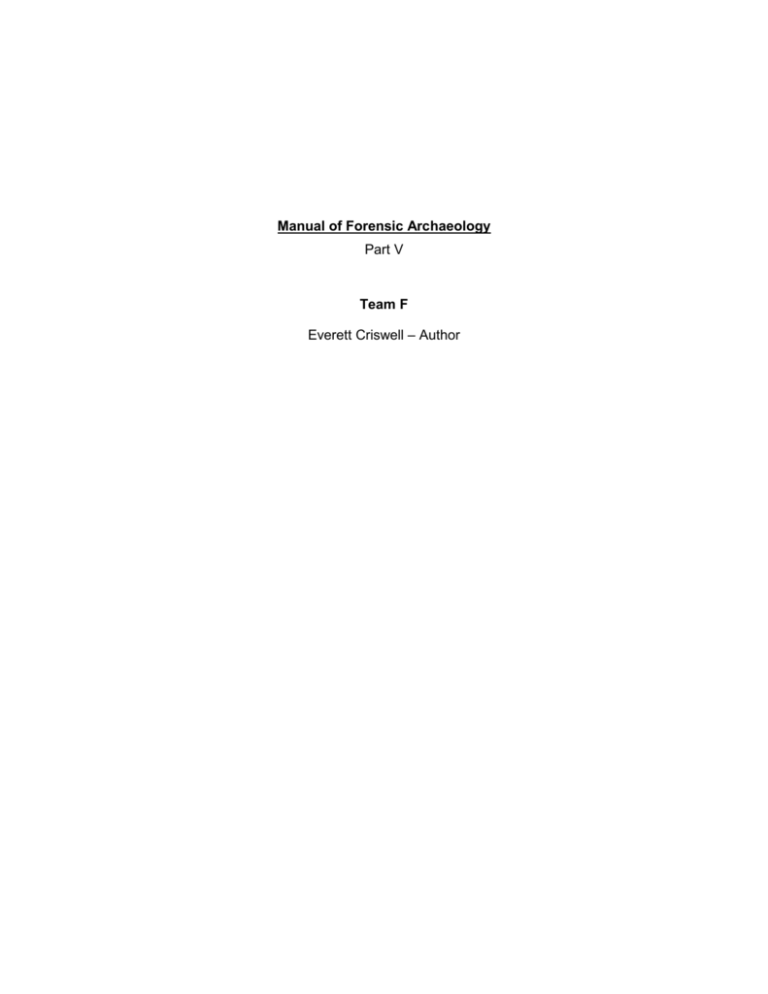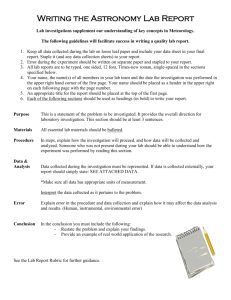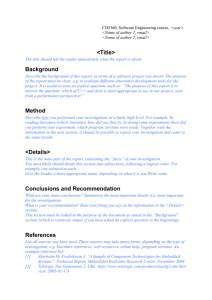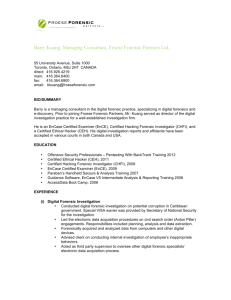Forensic Archaeology Manual Part 5
advertisement

Manual of Forensic Archaeology Part V Team F Everett Criswell – Author Essential to the field of forensic archaeology is the proper management and processing of all data recorded in the field. Data obtained before, during, and after an investigation of any kind is very important because that information can be used in a court of the law. Good management of information found during an investigation includes properly labeling and storing all materials and evidence found at the site, as well as taking very detailed and intricate notes throughout the investigation. Processing the data and materials collected means maintaining a good chain of custody. All of this is critical to ensuring that cases are investigated as thoroughly as possible. If an excavation is performed, everything found during the process must be photographed, thoroughly documented regarding location, depth, and identification of what was found. This includes items of clothing, tools, weapons, bones, hair, partially decomposed soft tissue and any other items found at the site that could possibly constitute as evidence. All data concerning the items must be properly logged and organized, and the items themselves need to be correctly labeled and stored with care, taking into consideration the type of material found. Special care needs to be taken for the storage of any organic remains, especially soft tissue. The usual technique for conservation of soft tissue is refrigeration, which in most cases will easily prevent desiccation. However, in more specialized cases, depending on the condition of the organic material, other methods of preservation have been used. The famous Bog Bodies found in Northern Europe, such as the Tollund Man pictured below are protected from decomposition using freeze drying techniques. Because of a severe lack of good conservation methods when Tollund Man was discovered, most of the body decayed. In fact, only his head is original today (Omar 1989). Both techniques of preservation can be employed on any forensic case where organic material is found, specifically human remains. Figure 1: Tollund Man Of equal importance is taking very detailed notes both in the field and before the investigation actually takes place, taking into consideration all data that might be relevant to the investigation. This includes information such as the latitude, longitude and elevation of the site or area of work. It is important before gathering data in the field to assess the nature of the field and its surrounding environment. The geologic features at and around a potential site are important to take note of. The primary types of rock, soil type and composition, presence of karst topography (caves/sinkholes/large deposits of limestone and/or dolomite), mountains/large hills and bodies of water can indicate the types and rates of erosion that take place in the area. It may also be of value to test any nearby bodies of water for acidity, pH, and alkalinity to gauge the dissolving power of the water. All of these can provide an indication of the condition we can expect to find evidence in. At the site itself it is very import to note any disturbance in the soil that does not appear natural. This can be on the surface or at any depth. When in the field, during the investigation, it is very important to take notes and collect data on anything that may seem significant. Taking photographs of all evidence found and documenting the location of where it was discovered are both very important, but also of value is taking note of the condition the items are in. If tools or other metallic objects are found that are heavily rusted or otherwise highly oxidated, it is important to note that because that information can provide a rough idea of how long a burial has existed. Certain types of fabric can decompose over time, especially during warmer months. Damage to items, such as clothing, tools, protective gear, and human remains are important to document because they can indicate what may have occurred at a particular site. Possible weapons are very important to take note of for exactly the same reason. For data processing during and just after an investigation it is necessary to fill out with as much detail as possible various types of forms. These include Excavation Level Forms, Excavation Summary Forms, Feature Level Forms, and Feature Summary Forms When in the process of collecting evidence and processing data, everything within reason should be taken from the site. This includes all possible evidence found during the investigation and any excavations that take place. These items must be properly packaged. This includes labeling with detail and care all items and bags/boxes/packages that items may be stored in. As discusses above, it also means carefully managing all items that need some kind of preservation. Chain of custody must always be maintained throughout a period of processing. As a current example for data processing, a 6,500 year old city in Bulgaria, the oldest ever found in Europe was recently discovered and excavated. This city included two story houses, numerous pits used for rituals, and a necropolis or burial site (Smithsonian 2012). Obviously this kind of case will require careful handling, identification, labeling and packaging of all artifacts found at the site. Human remains found at the necropolis will require preservation using various techniques before storage. Good data management and processing is paramount in forensic archaeology. It is critical to keeping a good record of what was found at the site, and what the evidence implicates about the situation that occurred there. Any data collected can be used by law enforcement or in court, so it very important to keep very thorough and comprehensible notes during an investigation. Evidence found must be properly handled, identified, labeled, and stored. Especially during forensic cases, photography is very important in keeping a thorough record of excavations. Many cases are resolved because of excellent data processing and management. Works Cited Omar, S. The Conservation of Bog Bodies By Freeze Drying. 1989. http://nautarch.tamu.edu/class/anth605/Readings/Omar%20McCord%20&%20Daniels.p df Smithsonian. Newly Uncovered, 6,500-Year-Old Fortified Stone City the Oldest in Europe. November 1, 2012. http://blogs.smithsonianmag.com/smartnews/2012/11/newly-uncovered-6500-year-oldfortified-stone-city-the-oldest-in-europe/








